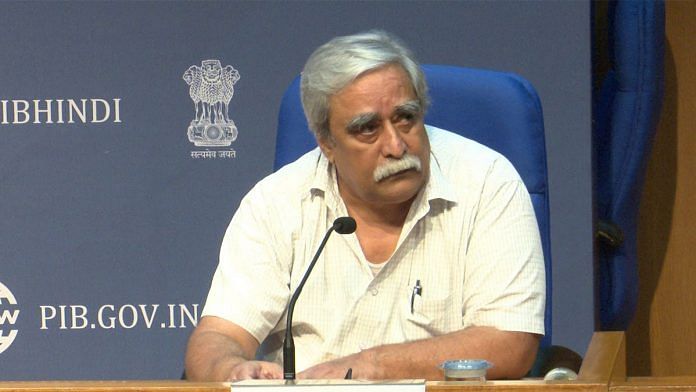New Delhi: Today was the last day at work for Dr Raman R. Gangakhedkar, head of epidemiology and infectious diseases at the Indian Council of Medical Research (ICMR), and for several months now, the face of the Covid-19 communication from India’s apex medical research body.
A paediatrician by training, the moustachioed Dr Gangakhedkar had earned quite a following in the last three months with his patient and simple explanations about the mysteries of the novel coronavirus.
Most prominently, his penchant for straight-talk as opposed to the long winded bureaucratic replies of others had made him a popular addition to press briefings. His hallmark was his ability to break down complicated scientific concepts into colloquial Hindi.
However, Dr Gangakhedkar is best known for what is known in scientific circles as the “married monogamous” paper — a seminal scientific paper on HIV AIDS in India that exposed the vulnerabilities of Indian women to the infection.
Always gracious with media queries, when asked for a comment, he texted back saying, “Can I call after July 2. [It is] a little emotional day for me.”
He also informed ThePrint that he will be joining the Dr C.G. Pandit National Chair of ICMR and will be operating from Pune henceforth. It is a distinguished position offered to retired, medically-qualified persons, usually for a duration of five years. At a given time, only two such chairs can exist
Also read: No ICMR panel or GoM meetings, no briefings — Modi govt ‘retreats’ even as Covid cases surge
Man behind Covid communication
Some of the most prominent statements made in the last few months on Covid-19 can be attributed to Dr Gangakhedkar.
He was the one who revealed that there were three different strains of the virus in India, the fact that 69 per cent Indian patients were asymptomatic and he also emphasised on the need to use the RT-PCR test — the standard test used to detect Covid-19 — at the correct time to accurately detect presence of the virus.
As over eager journalists plied him with questions, Dr Gangakhedkar — who had earned the moniker Ganga chacha on Twitter — patiently explained how the viral load is the highest nearer to the time when symptoms appear rather than when the first exposure to the virus happens.
However, sources privy to the pre- and post-briefing deliberations disclose that the scientist was not always in agreement with the statements made by the government. For example, when for days the government narrative centred around the Covid “success story” of doubling time, he had sounded a warning.
A government official, who wished to remain anonymous, says, “He had made the point that doubling time in itself can be misleading. Even one to two is doubling he had said, how could that alone be used as a metric to measure the course of the epidemic. It was not heeded.”
Seminal research and work on HIV
Dr Gangakhedkar, however, is most well-known for his research and work on HIV, that he started in 1980s in Mumbai.
Soon after, he started working in National AIDS research institute (NARI) in Pune, where his work revolved around involving the community to control AIDS by working closely with sex workers, homosexuals and drug users. His research on mother-to-child transmission was instrumental in rolling out the prevention of parent to child transmission (PPTCT) programme in 2002.
While at NARI, Dr Gangakhedkar was sent to Johns Hopkins University in the US on Fogarty Fellowship where he completed a degree in Masters in Public Health, which he revealed was instrumental in shaping his career.
“A student who had studied in a Marathi medium zilla parishad school, after coming back from the best public health institute in the world, I knew what kind of research I wanted to do,” he said in an interview to Marathi website Lokmat.
Dr V.M. Katoch, former director general of the ICMR, remembers Dr Gangakhedkar as the director of NARI when he held the top post at ICMR. ”As a clinician, as a doctor and as a clinical researcher he did great work there.”
Also read: RECOVERY trial shoots down possibility of lopinavir-ritonavir as Covid treatment
The ‘married monogamous’ paper
His most important contribution to the scientific community was of course his ‘married monogamous’ paper.
The seminal work was published in the Journal of the American Medical Association (JAMA) in 1997. It looked at women who attended STD clinics in Pune from 13 May 1996 to 11 July 1996.
The study showed how married women who had single partners were being exposed to the virus, which is often associated with promiscuity, because of the high-risk behaviour of their husbands.
According to Dr Sheela Godbole, head of epidemiology at the National AIDS Research Institute, “It reported a very important finding about the vulnerabilities of Indian women — how women with no risky behaviour of their own, were being exposed to HIV because of their husbands.”
The article reported, “Of 916 women enrolled, 525 were FSWs (female sex workers) and 391 were non-FSWs. Prevalence of HIV in FSWs and non-FSWs was 49.9% and 13.6%, respectively.”
It revealed that risk of HIV in non-FSWs, who were previously thought to be a low-risk category, was on the rise. Furthermore, since history of sexual contact with their only sex partner was the only risk factor associated with the infection, the study concluded that these women were being infected by their partners.
The paper underscored the need for “strengthening partner-notification strategies and counselling facilities in India”.
And the man behind this seminal study was likened to God by his colleagues.
Dr Godbole, who has authored several papers with Gangakhedkar, says, “He has always been a beloved of all his patients, to his patients, he is next to God.”
Also read: ‘Worst is yet to come’: WHO chief gives countries strict warning to contain Covid spread




India still functions because of a few good men in government service like Dr Gangakhedkar. Salute to this great human being.